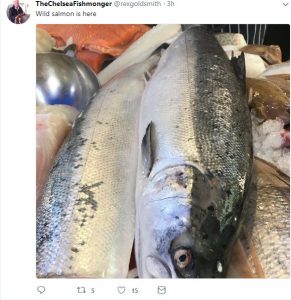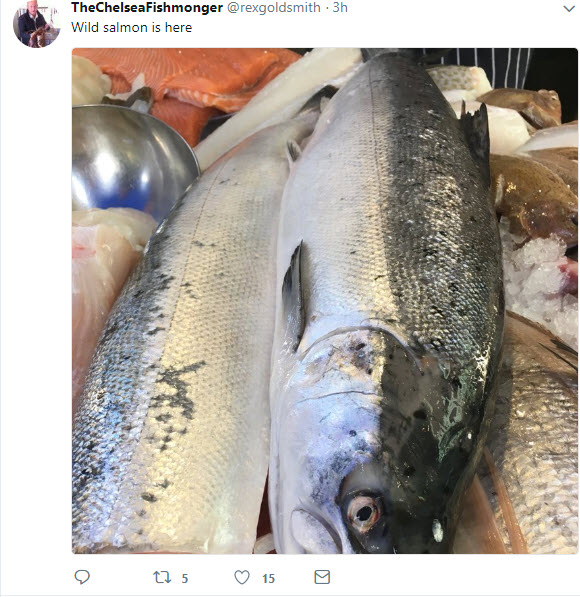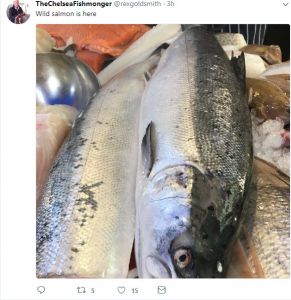Challenge two: The REC Committee may have finished gathering evidence but those who lobby against the salmon farming industry have continued their attacks, no doubt hoping still to influence the Committee’s findings. This week, the Times published an article suggesting that expansion of the industry can only come if environmental issues are addressed.
Amongst those expressing their view in the article was Andrew Graham Stewart of Salmon & Trout Scotland (sic) which supports the conservation of wild fish stocks, although, as we have pointed out previously, not enough to demand a ban of the killing of all wild fish. Mr Graham Stewart told the newspaper that; ‘It beggars belief, given the damming conclusions of the environment committee report, that planning permissions are still being granted for new farms as well as farm extensions’.
We, at Callander McDowell, are always interested in what Mr Graham Stewart has to say because he is so forthright with his views, at least when it comes to the press, or to those whose knowledge of the industry is limited. By comparison, Mr Graham Stewart is extremely reluctant to express his views to people like us. We are not sure why. Surely, if he is so concerned about the threats to wild salmon and sea trout, he might be expected to speak to everyone he can to pursue his case.
We have previously made attempts to meet with Mr Graham Stewart without success. However, the debate has moved on since then and therefore we are prepared to try again. We would like to issue an invitation to Mr Graham Stewart to meet, even just for an informal chat.
We believe that the wild and farming sectors can co-exist and live and work together in harmony. This will never happen if we never talk. The invitation has been extended. There are no strings attached. We hope that Mr Graham Stewart will now take that step.
We can only try.
Farmed & Dangerous: Scottish Sea Farms have issued a small booklet on behalf of the Scottish salmon industry separating facts about the industry from the fiction https://www.scottishseafarms.com/media/1553/reported-versus-reality.pdf
The anti-salmon farm lobby in the form of Don Staniford has been quick to respond but one of his comments caught our eye. He begins his usual claims by saying ‘Scottish salmon is farmed and Dangerous’.
This reference is of interest because ‘Farmed & Dangerous’ was one of the major campaigns set up after 2000 by the big US charitable foundations to disrupt and undermine the salmon farming industry. Following on from his involvement in the US based SumOfUS, we would ask is his reference to Farmed & Dangerous an indication that Don Staniford is part of a renewed but continued campaign paid for by these US foundations to disrupt the international salmon farming industry in order to safeguard wild US salmon fisheries. It is entirely feasible. The flow of money into the fisheries sector has never stopped although the focus has been towards the introduction of increasingly stringent certifications, yet there is no reason why the campaigns should not be double pronged.
We only hope that the REC Committee don’t succumb so easily to international manipulation as others have and remember this is about Scotland, not wild fisheries many thousands of miles away.
Seasonality: By coincidence, as we start again to discuss issues relating to the market, the Times newspaper has published its ‘Ultimate Guide to Seasonal Fish’.
We are just pleased that consumers are eating any fish to worry if the fish are judged to be seasonal or not. The paper says that 80% of the fish we eat falls into a group known as the Big Five – cod, haddock, salmon, tuna and prawns – 40% of which is farmed. We don’t have a problem with consumers eating the Big Five as long as, in our view, they are eating fish.
The Times guide offers a different view with its author Rachel Walker visiting the Chelsea Fishmonger, a local fishmonger located just off the fashionable King’s Road. She says that its street-front counter is an ode to British springtime with Scottish lobster, turbot, sea trout, plaice, brill and crab. She says that most of the fish on display have finished spawning and are now back on the counter after months of absence. The fish have replenished their stocks and are now in prime condition for the table. Ms Walker says this seems straightforward enough, but the Marine Conservation Society have produced a seasonality table that roughly outlines when fish can be eaten. She also consulted Michelin starred seafood chef Nathan Outlaw who suggests that the seasonality is less predictable than it used to be. He suggests that consumers talk to the fishmonger to obtain a recommendation for the best to eat at that time.
However, CJ Jackson from the Billingsgate Seafood School points out that just because a fish is on a fishmonger’s counter doesn’t mean it is in season. She says that fish often get caught in a mixed net and are landed out of season, so something like plaice will crop up in a fishmonger’s all year, but she says that whether it is the right time of year to buy it and eat it is another thing. She added that it often requires an expert eye to spot the give-away signs as to whether the fish are in season (plaice – May to December). She says to speak to the fishmonger who might suggest that the fish is ‘skinny’ meaning it is still in breeding condition. We presume she means to speak to the same fishmonger who is displaying out of season fish on the counter. Just because the fish has been caught inadvertently doesn’t mean that the fishmonger has to buy it in the same way that neither does the consumer. It seems to us that this is a real minefield.
Clearly, it is a minefield, not least because Ms Walker has pointed out that the Chelsea Fishmonger had sea trout on display on its counter. As regular readers will know, salmon farmers have been accused of decimating stocks of wild sea trout in Scotland although it seems that all stocks irrespective of their geographic location are under threat. Wild sea trout may not be the best choice for consumers to buy. The Times guide simply states ‘Trout – April to October – both sea trout and brown trout are in season’. The Marine Conservation Society Good Fish Guide are not able to shed any further light on whether sea trout are a good choice or not. They state: Wild sea trout populations are threatened in some areas. Only eat wild line caught sea trout from well managed fisheries such as rod and line fisheries. Avoid eating fresh sea trout caught during the breeding or spawning season from November to March inclusive’. It seems as clear as mud. The Chelsea Fishmonger website includes a page about the fish they sell. This includes information whether the fish is farmed or wild caught. Most wild caught fish come from Cornwall. The entry for sea trout states: The princely wild sea trout is a beautiful silver fish with and exquisite clean taste. Simply bake with a little butter, lemon and serve warm’.
Whilst looking for trout on the Times Guide of seasonal fish, we noticed that there was also an entry for salmon. This states: ‘Year round’, so not seasonal at all. The entry continues; Avoid wild salmon (netted June to August) and opt for farmed salmon from ethically accredited sources’, yet we noticed this week that the Chelsea Fishmonger tweeted this image:

Clearly as it is not yet June, it must be OK to stock wild salmon. We don’t know its origin but their website states: ‘Our salmon is farmed in the crystal-clear waters off the Shetland Isles and is transported to London every day. In the summer, we stock wild salmon from Scottish rivers, a real treat that must be cooked as simply as possible’.
The Marine Conservation Society red list all wild salmon giving them a rating of 5. It doesn’t matter if it is seasonal or not, the MCS say wild Atlantic salmon should be avoided. As already mentioned, the Chelsea Fishmonger also stocks farmed salmon. The MCS’s position on farmed salmon is less clear, if not confusing.
The MCS surprisingly submitted evidence to the REC Committee and this was followed up on their website with a commentary asking: ‘Is Scottish farmed salmon sustainable?’ We are not sure if they know the answer. They rate farmed salmon as either a 2 – green or 3 – yellow. A 2 means that it is OK to eat, and a 3 means eat but not so often. In their commentary, MCS repeat the usual arguments against salmon farming but not the issue of feed which they mention in the Good Fish Guide. We, at Callander McDowell have always been surprised that the MCS criticise the salmon farming industry for using fishmeal but have never commented on the widespread use of fish to feed pet cats.
Anyway, the MCS don’t exactly answer the question as to whether Scottish farmed salmon is sustainable or not. They just say that they believe the salmon industry should not consider any further expansion. Meanwhile, they recommend consumers should make environmentally responsible choices when buying salmon. They recommend organic farmed salmon or certified wild Pacific salmon (usually tinned) as the best choices. We cannot imagine that anyone wanting to buy a piece of farmed salmon could be persuaded that tinned Pacific salmon is a better choice but then perhaps the MCS aren’t even that sure. This recommendation demonstrates a lack of market awareness. There are other choices available.
The MCS website includes a ‘Fish of the Month’ page destined to help consumers choose a sustainable fish that is not in their breeding season. The full list for May, which includes only fish rated 1, 2 or 3, is as follows:
Arctic Char
Sea bass (farmed)
Sea bream
Cod
Coley
Crab brown
Gurnard Red
Haddock
Herring
Mussel (farmed)
Pollack
Pouting
Prawns Northern
Salmon (farmed)
Trout Rainbow
Turbot (farmed)
It appears that, according to the Marine Conservation Society, farmed salmon is a sustainable choice, not just for May but every month of the year as are three other species belonging to the Big Five. In all our discussions and deliberations over the years, no-one has ever mentioned the MCS ‘Good Fish Guide’. We can understand why. We very much think that the MCS are out of touch with both consumers and the market. Consumers choose fish on whether they like it, whether it looks good and if it’s the right price.
Most consumers get put off by talk of sustainability and if such talk leads to confusion, they just stop buying fish altogether. If the fish and seafood industry want to increase fish consumption amongst the public, it needs to focus on what the consumer actually wants. We don’t think seasonality is that important. After all, most consumers would think that if it’s in the shops, then it must be in season. Just looking at the MCS list for May, four out of five of the Big Five are included. The fifth, tuna, doesn’t even appear on their list of seasonal fish.
US access: Last week, Mark Ruskell MSP accepted a petition from anti-salmon campaigner Don Staniford. As this month’s Fish Farmer magazine points out, the two appear to be in cahoots. Mr Ruskell is keen to see much more stringent controls imposed on the salmon farming industry which he does not see as being environmentally friendly.
It was therefore of some surprise when earlier this year, he expressed concern that Scottish farmed salmon might be excluded from the US market when the new US import rules come into effect. The Marine Mammal Protection Act (MMPA) could impact on salmon producers who kill seals in order to protect their stocks. Of course, Mr Ruskell is not that bothered about the salmon industry but rather wants to see an end to the killing of seals,
However, it seems that it is not just importers who are concerned about the implications of the new law. Fish Farming Expert reported that the new law is under fire from officials trying to protect wild fish in the State of Oregon.
Oregon Department of Fisheries and Wildlife are concerned about the state of the run of wild steelhead trout in the Willamette River. This year the number of returning fish stands at 1,338 which is well below historic runs which exceeded over 10,000 individuals. As there is no salmon farming in Oregon, the decline in the run must be for some other reason and that is the presence of sea lions and Stellar seals. The population of sea lions is estimated to be nearly 300,000 animals and is considered healthy. About 25 of this population have stationed themselves at the Willamette Falls and are preying on passing salmon, steelheads. sturgeon and lamprey. It has been estimated that at least 18% of the steelhead population has been consumed. Previously ODFW might have shot these sea lions but can no longer do so. Instead, they opted to relocate the animals. Ten of the sea lions were transported to a beach 210 miles away. All the marked animals were back in Willamette within 4-6 days. One was transported away twice but returned on both occasions.
ODFW have now given up trying to save the wild fish of the Willamette River. Instead, they have transferred their attention to Bonneville, where the agency has existing permission to lethally remove sea lions. ODFW are now applying to the federal government to shoot sea lions at Willamette under Section 120 of the new law, although this may take over a year to be approved.
Perhaps, the problems of sea lions on the US west coast may bring the US federal government to realise that safeguarding one species may impact on another. Certainly, the seal population along Scotland’s west coast have exploded in recent years. Could it be that like at the Willamette River, seals are widely preying on wild salmon and sea trout and that it is the local wildlife rather than salmon farming is to blame for the ongoing decline in wild fish catches. Of course, unless the wild fish fraternity are prepared to discuss such a possibility, we will never know.


